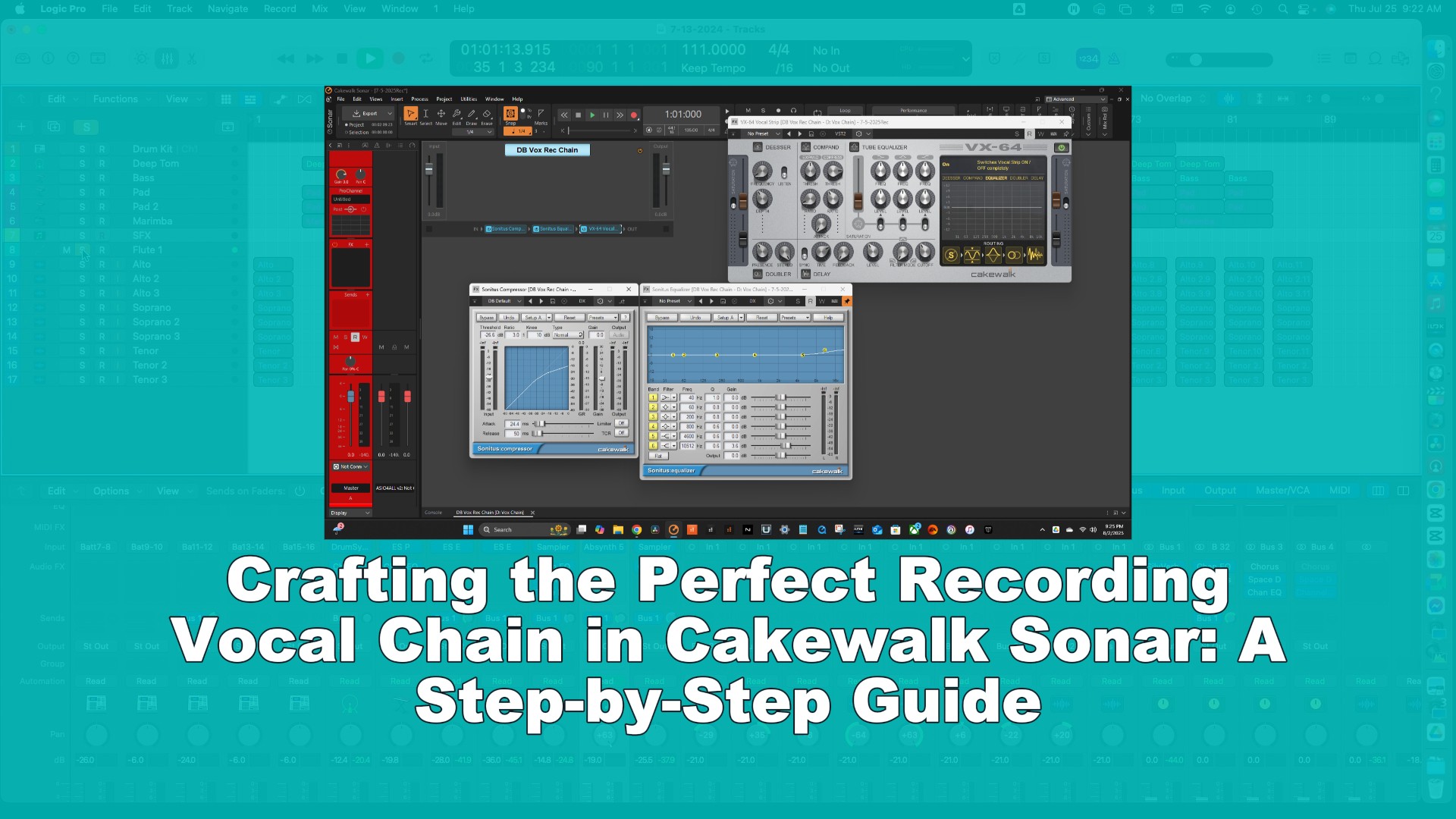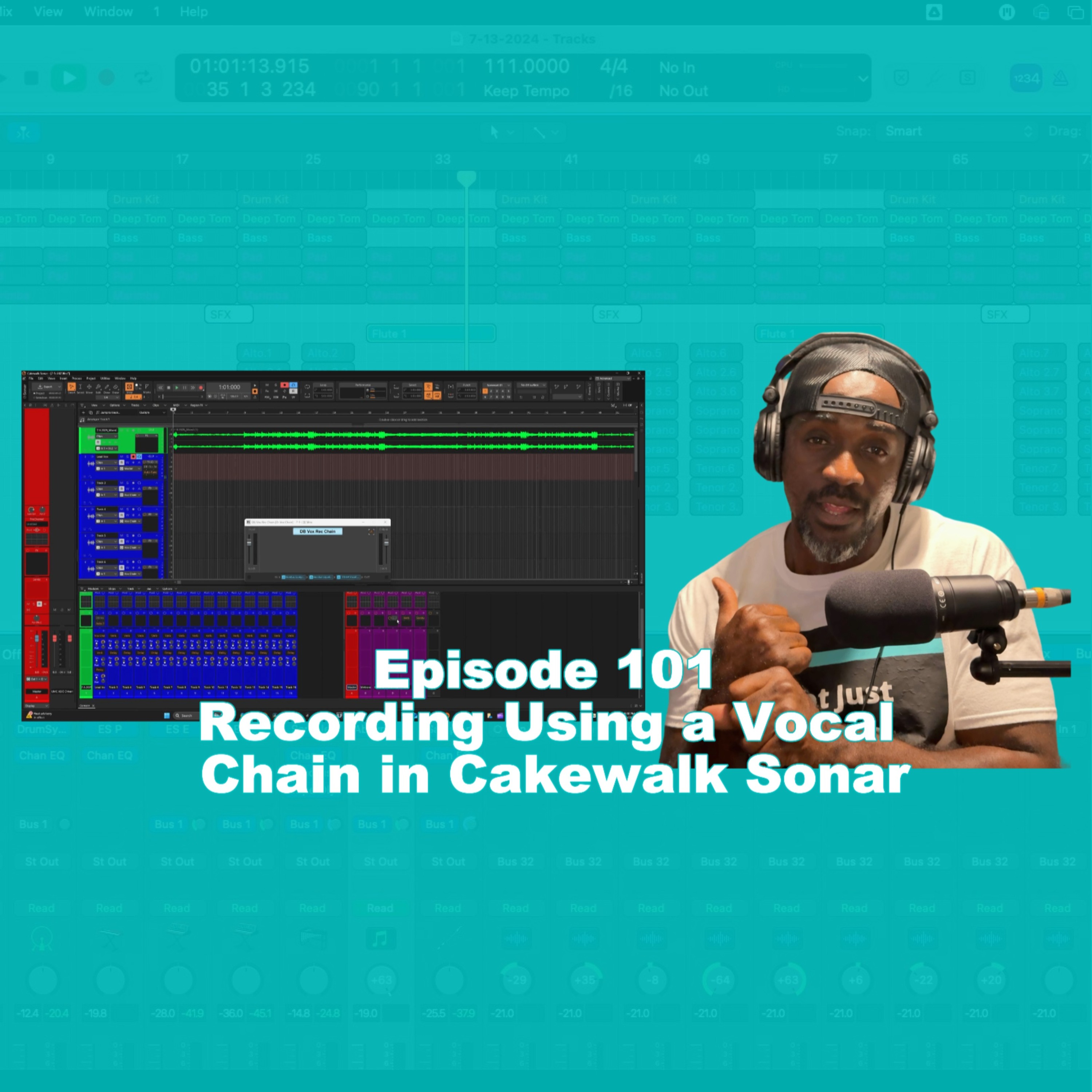Crafting the Perfect Recording Vocal Chain in Cakewalk Sonar: A Step-by-Step Guide

Welcome to the blog, music enthusiasts! In this post, we're diving deep into the art of crafting the perfect vocal chain within Cakewalk Sonar. A well-designed vocal chain is the secret weapon for achieving professional, polished vocal recordings. It's more than just throwing a few plugins together; it's about understanding the purpose of each element and how they interact to enhance your singer's performance. We'll cover everything from setting up your recording environment to tweaking essential plugins like EQ, compression, and de-essers. This comprehensive guide will empower you to transform raw vocal tracks into studio-quality masterpieces. And remember, for a more in-depth discussion and real-time demonstrations, be sure to check out Episode 101: Recording Using a Vocal Chain in Cakewalk Sonar of the Not Just Music Podcast. The episode dives into microphone techniques, plugin choices, and practical tips to elevate your recordings. Let’s get started!
Understanding the Basics: What is a Vocal Chain?
Before we jump into the specifics, let's define what we mean by a "vocal chain." Simply put, a vocal chain is a series of audio processing plugins applied sequentially to a vocal track. Each plugin performs a specific task, such as shaping the tone (EQ), controlling the dynamics (compression), or removing unwanted sibilance (de-essing). Think of it like a production line for your vocals, where each station contributes to the final product. The signal from your microphone passes through each plugin in the chain, undergoing various transformations until it reaches its final, polished state. The goal is to create a smooth, balanced, and professional-sounding vocal that sits perfectly within your mix. Without a well-crafted vocal chain, your vocals might sound thin, muddy, inconsistent, or simply lack the impact needed to capture the listener's attention. The right chain can take a good vocal performance and elevate it to a truly exceptional one.
Step 1: Setting Up Your Recording Environment in Cakewalk
The foundation of any great vocal recording is a solid recording environment. Cakewalk Sonar provides the tools you need to optimize your setup. First, ensure your audio interface is properly configured within Cakewalk's preferences. This will allow Cakewalk to communicate with your microphone and speakers. Next, create a new audio track specifically for vocals. It's good practice to label this track clearly (e.g., "Lead Vocal"). When setting up the track, make sure your input is correctly assigned to the microphone input on your audio interface. Monitoring is key: enable input monitoring on the vocal track to hear your voice through your headphones in real time. This allows you to make adjustments to your microphone position and gain settings before recording. Speaking of gain, set your input level carefully. Aim for a healthy signal without clipping (distortion). The sweet spot is usually around -18dBFS. Use Cakewalk's level meters to monitor your input and make adjustments as needed. A clean, well-optimized recording environment is the first step towards a professional-sounding vocal track.
Step 2: Choosing the Right Microphone
The microphone is the first point of contact for your vocal performance, and choosing the right one can make a world of difference. Different microphones have different characteristics that can flatter various vocal styles. Condenser microphones are generally preferred for vocals due to their sensitivity and ability to capture subtle nuances. Large-diaphragm condensers tend to provide a warmer, fuller sound, while small-diaphragm condensers offer a more transparent and detailed capture. Dynamic microphones, on the other hand, are more robust and better suited for louder sources or live performances. They are less sensitive than condensers and tend to have a more focused sound. Experiment with different microphones to find the one that best complements your vocalist's voice and the style of music you're recording. Consider factors like proximity effect (the increase in bass response when the microphone is close to the sound source) and polar pattern (the directionality of the microphone). A cardioid polar pattern, which picks up sound primarily from the front, is often a good choice for vocals as it helps to minimize background noise and room reflections. Remember to use a pop filter to reduce plosives (bursts of air from "p" and "b" sounds) and a shock mount to isolate the microphone from vibrations.
Step 3: Essential Plugins for Your Vocal Chain
Now that we've covered the basics of recording, let's dive into the heart of the vocal chain: the plugins. While the specific plugins you use will depend on your individual needs and preferences, there are a few essential tools that every vocal chain should include. First, an equalizer (EQ) is crucial for shaping the tonal balance of your vocal, removing unwanted frequencies, and enhancing the clarity and presence. Second, a compressor is essential for taming the dynamics of the vocal, reducing the difference between the loudest and quietest parts, and adding punch and sustain. Third, a de-esser is used to reduce harsh sibilance ("s" and "sh" sounds) that can be distracting and unpleasant. Beyond these essentials, you might also consider using a gate to reduce background noise, a saturation plugin to add warmth and character, and effects like reverb and delay to create depth and space. The key is to use these plugins strategically, with a clear understanding of their purpose and how they affect the sound. Remember, less is often more. Start with subtle adjustments and gradually increase the processing until you achieve the desired result.
Step 4: EQ - Sculpting Your Vocal Tone
Equalization (EQ) is the art of shaping the tonal balance of your vocal, and it's a critical step in creating a professional-sounding recording. The goal of EQ is to remove unwanted frequencies, enhance desirable frequencies, and create a smooth, balanced sound. When EQ'ing vocals, start by identifying any problem areas. Listen carefully for muddiness in the low frequencies (typically below 250Hz), harshness in the mid frequencies (around 2-5kHz), or excessive sibilance in the high frequencies (above 5kHz). Use a narrow EQ cut to sweep through these frequency ranges and identify the specific frequencies that are causing problems. Once you've identified the problem areas, use gentle cuts to remove the unwanted frequencies. Be careful not to overdo it, as excessive EQ can make the vocal sound thin or unnatural. Next, consider boosting frequencies that will enhance the clarity and presence of your vocal. A gentle boost in the upper mid frequencies (around 3-5kHz) can add clarity and definition, while a boost in the high frequencies (above 8kHz) can add air and sparkle. Again, use subtle adjustments and listen carefully to the results. A high-pass filter (also known as a low-cut filter) is often used to remove rumble and low-frequency noise below the fundamental frequency of the vocal. This can help to clean up the low end and prevent muddiness. Cakewalk Sonar has a range of EQ plugins, so try a few out and experiment.
Step 5: Compression - Taming Dynamics and Adding Presence
Compression is a powerful tool for controlling the dynamics of your vocal and adding punch, sustain, and presence. A compressor works by reducing the dynamic range of a signal, making the quiet parts louder and the loud parts quieter. This can help to even out the level of your vocal, making it sit better in the mix and adding a sense of power and energy. When using compression, there are several key parameters to consider: threshold, ratio, attack, and release. The threshold determines the level at which the compressor starts to work. Signals above the threshold will be compressed. The ratio determines the amount of compression applied. A higher ratio means more compression. The attack time determines how quickly the compressor starts to work after the signal exceeds the threshold. A fast attack time will clamp down on the signal quickly, while a slow attack time will allow some of the initial transient to pass through. The release time determines how quickly the compressor stops working after the signal falls below the threshold. A fast release time will allow the signal to return to its original level quickly, while a slow release time will create a smoother, more sustained sound. Start with a moderate ratio (around 4:1) and a medium attack and release time. Adjust the threshold until you're getting a few dB of gain reduction. Listen carefully to the results and adjust the parameters to taste. Experiment with different attack and release times to find the settings that work best for your vocal. Use a second compressor if needed; serial compression can add a smoother sound to your vocal track.
Step 6: De-essing - Eliminating Harsh Sibilance
Sibilance, those harsh "s" and "sh" sounds, can be a major problem in vocal recordings. A de-esser is a specialized tool designed to reduce these unwanted sounds without affecting the overall tone of the vocal. A de-esser works by detecting sibilant frequencies and then applying gain reduction to those frequencies. Most de-essers have two key parameters: frequency and threshold. The frequency control determines the frequency range where the de-esser will be active. Typically, sibilance occurs in the range of 5-8kHz. The threshold control determines the level at which the de-esser starts to work. Start by setting the frequency to around 6kHz and then adjust the threshold until you're hearing a reduction in sibilance. Be careful not to overdo it, as excessive de-essing can make the vocal sound lisping or unnatural. A good de-esser should reduce the sibilance without significantly altering the overall tone of the vocal. Listen carefully to the results and make small adjustments until you achieve the desired effect. Some de-essers have a "listen" mode that allows you to hear only the frequencies that are being processed. This can be helpful for identifying the specific frequencies that are causing problems.
Step 7: Adding Effects (Reverb, Delay, etc.) - The Finishing Touches
Once you've sculpted the tone and dynamics of your vocal with EQ, compression, and de-essing, it's time to add some effects to create depth, space, and character. Reverb and delay are two of the most common effects used on vocals. Reverb simulates the sound of a vocal in a physical space, adding a sense of depth and ambience. Delay creates a repeating echo of the vocal, adding rhythm and movement. When using reverb, consider the size and characteristics of the virtual space you're creating. A small room reverb can add a subtle sense of ambience, while a large hall reverb can create a more dramatic and spacious sound. Adjust the decay time (the length of the reverb tail) to suit the tempo and style of your music. When using delay, experiment with different delay times and feedback settings. A short delay with minimal feedback can add a subtle thickening effect, while a longer delay with more feedback can create a more pronounced echo. Be careful not to overdo it with effects, as too much reverb or delay can make the vocal sound muddy or indistinct. The goal is to use effects subtly to enhance the vocal without overpowering it. Experiment with other effects as well, such as chorus, flanger, or phaser, to add unique textures and create interesting sonic landscapes. Always listen in context of the entire mix to ensure your effect choices complement the arrangement.
Plugin Recommendations for Cakewalk Sonar
Cakewalk Sonar comes with a suite of excellent plugins that can be used to create a professional-sounding vocal chain. For EQ, the built-in ProChannel EQ is a versatile and powerful option. Its clean and transparent sound makes it suitable for a wide range of vocal styles. For compression, the CA-2A T-Type Leveling Amplifier offers a warm and smooth sound reminiscent of the classic LA-2A compressor. The PC4K S-Type Channel Compressor is another great option, offering a more aggressive and punchy sound. For de-essing, the ProChannel De-Esser is a simple and effective tool for reducing sibilance. For reverb, the REmatrix Solo convolution reverb provides a wide range of realistic and natural-sounding reverbs. Experiment with these plugins to find the ones that work best for your vocal and your style of music. Don't be afraid to try third-party plugins as well. There are many excellent EQ, compressor, de-esser, and reverb plugins available from various manufacturers. Some popular choices include the Waves Renaissance series, the FabFilter Pro series, and the iZotope Ozone suite. The key is to find the tools that you're comfortable using and that deliver the sound you're looking for.
Pro Tips for Achieving a Professional Vocal Sound
Beyond the technical aspects of building a vocal chain, there are a few pro tips that can help you achieve a truly professional vocal sound. First, focus on getting a great performance from the vocalist. No amount of processing can fix a bad performance. Work with the vocalist to create a comfortable and inspiring recording environment, and encourage them to deliver their best performance. Second, pay attention to microphone technique. Experiment with different microphone positions and distances to find the sweet spot for your vocalist's voice. A good microphone technique can minimize the need for excessive processing. Third, use automation to add movement and dynamics to your vocal. Automate the level of your vocal to create subtle variations in volume, or automate the parameters of your effects to add interest and excitement. Fourth, listen critically and be willing to experiment. There's no one-size-fits-all solution when it comes to vocal processing. Be willing to try different plugins, settings, and techniques until you find the sound that works best for your vocal. Finally, don't be afraid to seek feedback from other engineers and producers. A fresh set of ears can often provide valuable insights and help you identify areas for improvement.
Conclusion: Elevate Your Vocal Recordings with a Well-Crafted Chain
Crafting the perfect vocal chain is a journey, not a destination. It requires a combination of technical knowledge, creative experimentation, and a keen ear for detail. By understanding the purpose of each plugin and how they interact, you can transform raw vocal tracks into polished, professional-sounding recordings. Remember to start with a solid recording environment, choose the right microphone, and use essential plugins like EQ, compression, and de-essing to sculpt the tone, dynamics, and clarity of your vocal. Add effects like reverb and delay to create depth and space, and don't be afraid to experiment with different plugins and techniques. Most importantly, focus on getting a great performance from the vocalist, and listen critically to the results. By following these steps, you can elevate your vocal recordings to the next level and create music that truly shines. Be sure to listen to Episode 101: Recording Using a Vocal Chain in Cakewalk Sonar of the Not Just Music Podcast for a deeper dive into these concepts and more practical examples. Happy recording!







